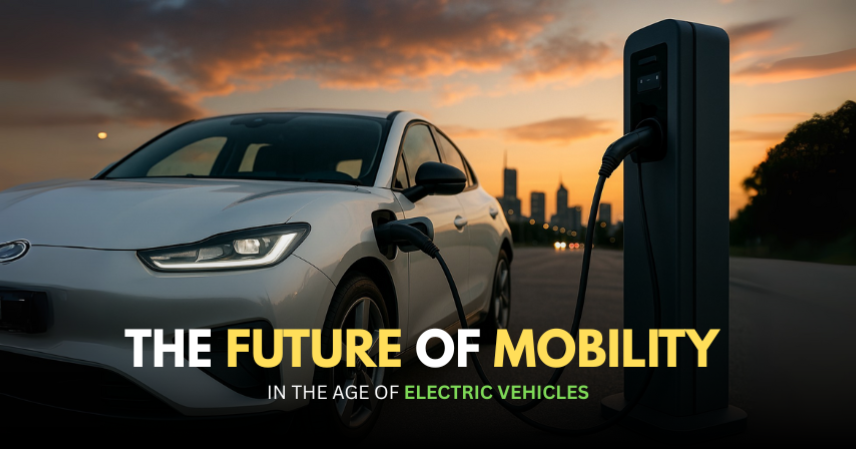Electric vehicles (EVs) have become a game-changer in how we get around as the globe faces both environmental urgency and technical progress. The age of electric mobility is not just a trend; it’s the future. Governments are pushing for higher emission standards, car companies are embracing electrification, and people are becoming more environmentally conscious.
Introduction: The EV Revolution
About 25% of all carbon dioxide emissions come from the transportation industry. Fossil fuel-powered internal combustion engine (ICE) cars have been a major source of air pollution and greenhouse gasses for a long time. As climate change speeds up and air quality in cities gets worse, it becomes more and more important to move toward transportation that is good for the environment.
Electric cars are a great answer. EVs don’t pollute the air at all because they run on rechargeable batteries. This makes them much better for the environment than gasoline or diesel cars. In the last ten years, improvements in battery technology, charging infrastructure, and cost have made electric vehicles (EVs) more popular.
The Growth of the EV Market
The International Energy Agency (IEA) says that more than 10 million electric vehicles (EVs) were sold around the world in 2023. This number is predicted to triple by 2030. To speed up this change, governments all around the world are giving money, tax breaks, and building new infrastructure.
India started the FAME II (Faster Adoption and Manufacturing of Hybrid and Electric Vehicles) program, and Norway and the Netherlands want to sell all new cars as electric cars by 2025 and 2030, respectively. There is a lot of rivalry in the worldwide EV industry, and both established car companies and new companies are putting a lot of money into research and development.
Regional Focus: EV Adoption Around the World
India
India has seen a big increase in the use of electric vehicles, notably in the two- and three-wheeler markets. The Indian government’s FAME II program, lower GST rates on EVs, and incentives at the state level are all helping to make the change happen. Tata Motors, Ola Electric, and Ather Energy are some of the companies that are leading the way in the US.
The United States
Tesla’s impact and the Inflation Reduction Act, which gives tax incentives for electric vehicles, have led to more people wanting to buy them in the U.S. Ford, GM, and Rivian are all adding more electric vehicles to their inventories. At the same time, states like California are working toward a future with no emissions.
Europe
Europe is still the world leader in the use of electric vehicles. Countries like Norway, where almost all new car sales are electric, exemplify what a successful transition looks like. They have strict emission rules and a lot of places to charge electric cars. Germany, France, and the UK are also putting a lot of money into EV infrastructure and incentives.
China
China has the biggest market for electric vehicles in the world, thanks to strong government policies and new ideas. BYD, Nio, and XPeng are the most well-known brands. The country is also the world’s largest producer of batteries, which makes it a key part of the EV supply chain.
Technological Innovations Driving EV Adoption
1. Improvements in batteries
Battery technology is the main reason why people are buying EVs. Lithium-ion batteries are now lighter, more energy-dense, and less expensive. Solid-state batteries, which promise even longer range and faster charging, are coming soon. A lot of money is going into this area from companies like Toyota and QuantumScape.
2. Charging Infrastructure
More public charging stations, fast-charging networks, and home-charging options are making people less worried about running out of battery. Companies like Tesla, Ionity, ChargePoint, and India’s Ather Grid are helping to construct big charging networks.
3. Integration of Smart Mobility
Smart transportation platforms are becoming more and more connected to EVs. Features like regenerative braking, remote diagnostics, AI-powered navigation, over-the-air (OTA) upgrades, and app-based controls make driving more fun, efficient, and safe.
4. Technology that connects cars to the grid (V2G)
Vehicle-to-grid (V2G) is a new technology that lets electric vehicles provide power back to the grid when they’re not being used. This could change how we manage energy and help people use more renewable energy.
Environmental and Economic Benefits
Fewer emissions
EVs don’t emit any pollutants from their tailpipes, which greatly lowers air pollution and greenhouse gasses in cities. Using renewable energy to make power also lowers lifecycle emissions. More people are using electric vehicles (EVs) in cities like Delhi, Los Angeles, and Beijing, which is already making the air cleaner.
Costs of running are lower
Because they have fewer moving components, EVs use less energy and are cheaper to keep up. Owners save money on gas, oil changes, and a lot of mechanical maintenance. Electricity is also a cheaper fuel than gasoline or diesel, especially in places where you may get discounts for using it at certain times.
Creating jobs and growing the economy
The EV revolution is opening up new jobs in making batteries, writing software, building charging stations, and using clean energy. It is also changing the supply chain in the auto sector by creating new demand for rare earth elements, semiconductors, and skilled workers.
Challenges in EV Adoption
Even if it is growing quickly, there are still a number of problems:
- High Initial Costs: Even if running costs are lower, electric cars (EVs) still cost more up front than internal combustion engine (ICE) vehicles. The cost of batteries is still the major factor.
- Limited Range: Entry-level EVs frequently don’t go as far on a single charge, which can keep people from driving lengthy distances. The average range, on the other hand, is getting longer every year.
- Charging Infrastructure: Charging networks are growing, although they are still few and far between in many rural and underdeveloped areas. There are still problems with standardization and the availability of rapid charging.
- Battery Recycling & Disposal: It’s important to take care of EV batteries throughout their lives and reduce their influence on the environment. Businesses are looking into ways to use things again and better ways to recycle them.
The Role of Policy and Regulation
Governments play a big part in speeding up the use of electric vehicles by:
- Incentives: EV buyers get subsidies, tax breaks, and lower registration fees.
- Regulations: Emission standards and prohibitions on ICE vehicles to encourage manufacturers to switch to electric vehicles. The EU, for instance, wants to stop making new diesel and gasoline cars by 2035.
- Infrastructure Development: Putting money into public charging networks, upgrading the grid, and adding renewable energy.
- Public Awareness Campaigns: Teaching people about the pros and downsides of owning an EV.
EVs and the Future of Urban Mobility
The rise of electric vehicles (EVs) is changing how people get around in cities:
- Shared Mobility: Electric taxis, ride-sharing, and bike-sharing services are becoming more popular, especially in cities with a lot of people.
- Many electric vehicles (EVs) are being made with self-driving features, which will make trips safer and more efficient.
- Urban Planning: Cities are changing their infrastructure to make room for electric vehicles (EVs). For example, they are adding smart parking, charging zones, and dedicated lanes. There are also more and more low-emission zones.
A Buyer’s Guide to EVs in 2025
If you’re thinking about getting an EV in 2025, here are some important things to think about:
- Range: Pick a car that works for your daily commute and the occasional lengthy travel.
- Charging Options: Think about if you can charge your phone at home, in public, or quickly in your region.
- Battery Warranty: Most companies give a warranty of 8 to 10 years, which shows they trust their batteries.
- Software and Features: Look for smart connection, over-the-air updates, and driver-assist technology.
- Total Cost of Ownership (TCO): Figure out how much you’ll save on gas, repairs, and taxes over time.
Looking Ahead: The Road to 2035 and Beyond
Many analysts think that by 2035, electric vehicles (EVs) will make up most of the new cars sold around the world. This transformation will be caused by things like lower battery prices, government rules, and consumer desire. Emerging markets will also be very important, with production happening in specific areas and solutions made just for them.
There will be a variety of alternative transportation technologies, such as hydrogen fuel cells, solar-powered vehicles, and others, that will work alongside EVs. Micro-mobility (e-scooters, electric bikes) and mobility-as-a-service (MaaS) platforms will change the way cities work.
Conclusion
Electric, networked, and long-lasting are the future of mobility. Electric vehicles (EVs) are going to change the way we travel, live, and communicate as innovation speeds up and problems are solved. Accepting this change will not only help the earth, but it will also lead to cleaner air, smarter cities, and a stronger economy.

